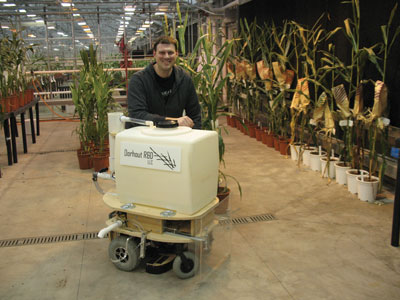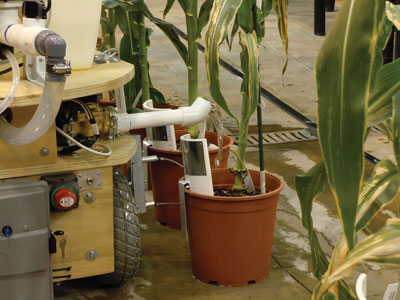
Features
Structures & Equipment
Water and irrigation
Robotic watering
March 20, 2013 By Dave Harrison
Last summer’s debut of a robotic watering system at a farm show in
Canada attracted considerable attention – and praise – from growers
viewing the prototype.
Last summer’s debut of a robotic watering system at a farm show in Canada attracted considerable attention – and praise – from growers viewing the prototype.
 |
|
| Aquarius designer David Dorhout says the system is accurate and efficient. PHOTOS COURTESY DAVID DORHOUT/AQUARIUS Advertisement
|
They also offered suggestions to help fine-tune it.
The Aquarius robotic watering system from Robot Farmers drew considerable attention at Canada’s Fruit & Veg Tech X-Change near Simcoe, Ont.
“We were excited to launch the Aquarius watering system during the Expo and the reaction from growers was very positive,” says Iowa-based engineer David Dorhout.
Dorhout works for a large biotech company that has 90,000 square feet of conventional greenhouse space. Due to the nature of the work, each plant has to be individually watered by hand.
He was approached by a manager in the fall of 2011 who wondered if the process could be automated. The challenge was eagerly accepted, and several months later a prototype was rolled out.
Dorhout, who has his bachelor’s and master’s science degrees from Iowa State University, has been working in agricultural research for the past 13 years. His interest in robotics began in his teens, and over the years he has designed a number of robots.
MONTHS OF FINE-TUNING SINCE DEBUT IN CANADA
■ Since its debut in Simcoe, Dorhout has continued to test and fine-tune the system to produce the first production model.
“We learned a lot talking with the growers and gained a better understanding of how we could configure Aquarius into a commercial greenhouse system as compared to the research greenhouse system that it was originally developed for,” says Dorhout.
For example, growers suggested it be made narrower, so that it could fit in a 60-centimetre row. “The production model that will be sold will be less than 50 centimetres wide, and will fit between typical production greenhouse rows.”
So how does it work? We’ll let the designer explain.
“To get started, the grower simply marks the path that they want the robot to follow through the greenhouse with a piece of tape that contrasts with the greenhouse floor. The floors in our testing greenhouse are a little bit dark with grated floor drains that run the length of the room, so we use shiny, inexpensive, aluminum tape.
“The grower then moves the robot so that it is centred on the line, adjusts the maximum amount of water they want the robot to dispense using a dial, and turns it on. The robot then automatically self-calibrates itself for the floor, detects the tape, and then starts following it, watering plants as it goes. The line can be changed at any time, even while it’s watering.”
MOISTURE SENSORS SPECIALLY DESIGNED FOR THE SYSTEM
■ The robot’s “sensor whiskers” will make contact with soil moisture sensors, or detect a pot if there is no sensor. The system then “measures” the soil moisture level, calculates how much water should be given and saves that value.
 |
|
| Watering on the go.
|
“The robot will then dispense that amount of water to every pot it detects with its pot detector until it sees another soil moisture sensor,” Dorhout explains.
This way a grower can decide if they want a soil moisture sensor in every pot for “precision” watering, or one per group/zone for “mixed” coverage, or no sensors at all for a “uniform” watering of all containers.
Aquarius holds 110 litres and can automatically refill itself when it runs out of water, returning to where it ran out of water. The next generation of Aquarius will have double or triple that holding capacity.
It can travel approximately 21 kilometres before needing to be recharged. Depending on spacing, it waters approximately 50 to 70 plants per minute using its left- and right-hand side watering system.
It’s impressive technology, and a number of technical, scientific and user interface challenges were hurdled, says Dorhout.
For starters, normal electronics don’t always fare well in greenhouse conditions. Aquarius has been “overbuilt and engineered” to withstand the excessive heat, sunlight and humidity levels. (Note that the prototype in the photos has a partially wooden frame; this will be replaced with an aluminum frame in the commercial version.)
The electric drive system uses precision industrial grade optical encoders that the computer uses to dynamically control how much power is given to each wheel. The computer adjusts the power distribution 10 times per second, ensuring the robot remains rock steady even when driving up and down pitched floors. Fully loaded, it weighs about 230 kilograms.
CAPACITY TO TACKLE 24 TASKS AT ONCE
■ It uses regenerative braking that recharges the batteries, just like in electric cars. In all, Aquarius uses four microcontrollers that have a total of 24 processors, which means that it can do 24 different things at once.
The second major breakthrough for Dorhout was in developing a soil sensor that could:
- Accurately measure soil moisture.
- Be read by a passing robot.
- Be durable enough to be autoclaved numerous times over the years.
- Be inexpensive enough that a grower could put one in every pot.
“The solution was to strip the sensor down to the basic essentials, break it into two parts, and use the robot to hold the ‘brains’ of the moisture sensor.”
The third challenge was to ensure the system was simple and intuitive to operate, something anyone could learn to operate in just a few minutes.
The result is a robot that has two switches. One is the on/off and the other is a dial to adjust how much water the robot would provide to a completely dry plant. Everything else is automatic and self-calibrating.
In a “precision” watering strategy, the grower wants the robot to measure the soil moisture in each pot and then dispense the correct amount based on a maximum value that the grower sets. This requires that each pot has its own moisture sensor.
These, durable, inexpensive, moisture sensors were designed to work specifically with the Aquarius robot, are autoclaveable, and cost about a tenth as much as a stand-alone sensor.
With proportional watering, sensor “whiskers” make contact with the contact surface of the moisture sensor and the robot reads the soil moisture in approximately 1/1000ths of a second. The robot then detects the pots, checks to see what the last soil moisture value was, calculates how much water it should be given, and then dispenses the correct amount of water.
“All of this is done without the robot slowing down or pausing.”
In “uniform” watering, the plants receive the same amount of water. The only thing the grower has to do is set the watering volume dial (which they can change at any time, even while it’s running). The robot detects the pots and waters them.
Growers can utilize a combination of “uniform” and “precision” strategies. A moisture sensor is placed in some of the pots, but not all of them. (The grower typically puts the moisture sensor in the first pot of a group of plants.)
The robot then simply reads the moisture sensor or uses the last stored value for calculating how much water to give each pot that it detects.
The system is easy to troubleshoot and service, says Dorhout.
It’s also a technology that can be expanded to a number of other agricultural applications. It could, for example, distribute feed or bedding for cattle or poulty. As well, it could collect things, such as harvested vegetables picked in a field.
Robotics will continue to play an ever increasing role in the lives of farmers, says Dorhout.
“Robotics gives them the opportunity to free themselves from operating their equipment, and instead concentrate on the business and science of farming.”
| Two major components in European robotics program Research worldwide on greenhouse robotics and automation systems is gaining momentum, and in particular in the Netherlands. Wageningen University & Research Centre has long been a lead player in Europe, partnering with industry and other educational centres to develop new systems to lighten the labour load in greenhouses. Erik Pekkeriet is the senior project manager at Wageningen UR Vision & Robotics. He has worked in the robotics field for 16 years. The technologies must also be commercially viable. It’s possible to transplant cacti with a vision-controlled robot quite precisely, but the market is quite small. On the other hand, the pepper market is large, and developing a robotic harvester would make good business sense. However, developing a robot that can match the performance of humans has so far been difficult. Wageningen is heading up a pair of European Union-funded research projects in agricultural robotics. CROPS PICKnPACK One is a sensing unit that assesses the quality of harvested produce before and after packaging. The second module is a vision-controlled robotic handling system that picks up and separates the product from a harvest bin or transport system and places it in the right position in the package. The third module is an adaptive packaging module that can accommodate various types of packaging with significant flexibility. |
For more information, check the website at www.DorhoutRD.com , or send an e-mail to DDorhout@DorhoutRD.
Print this page